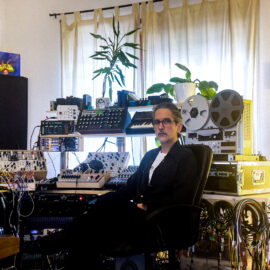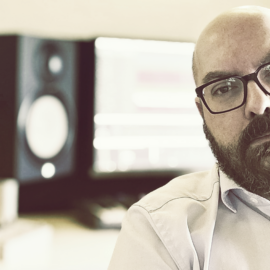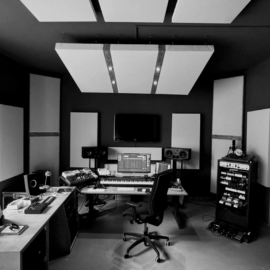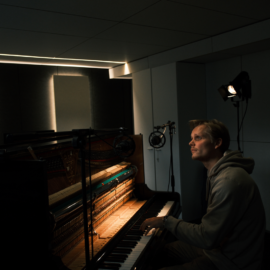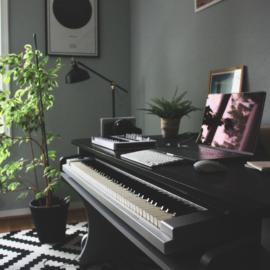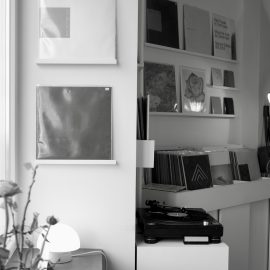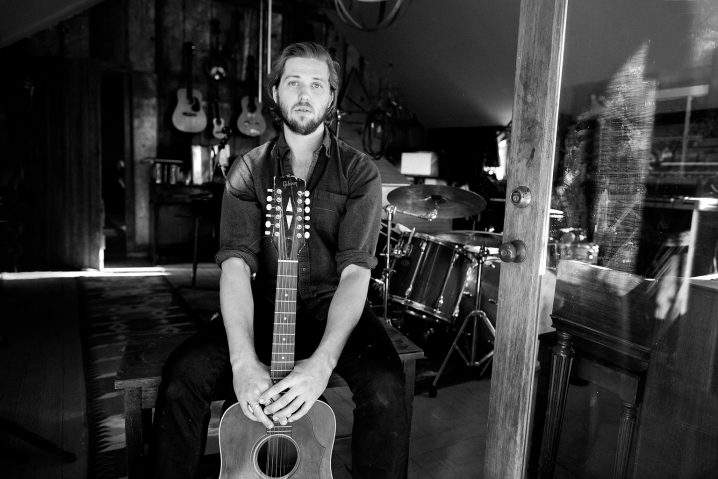
Lets start at the very beginning. Can you tell us how you got involved in composing, and what was your very first piece of gear?
When I was about twelve, I was convinced that the only viable career I could ever have and love was writing and recording music. I’m sure this conviction seemed crazy and unwarranted to my family and friends in rural Florida since I showed virtually zero interest in taking lessons, learning how to play songs that other people knew, or displaying any signs of focused potential aside from locking myself away and writing and recording my own weird little half songs any moment I could get.
In spite of not having any way to gauge if I was actually talented aside from the “interesting sounds” I was making with our family piano, my dad’s tenor guitar and banjo, and a karaoke machine tape deck, my parent’s were completely and unwaveringly supportive of me. When I was 13 they got me my first pieces of “gear” all of which I still own and use to this day; a 1980 Alvarez acoustic guitar, a Shure SM-57, and a Yamaha MT50 4 track. From that point on I pretty quickly became an unrepentant instrument monger and my instincts and tastes for recording, composing and studio experimentation gradually began to take shape.

How many different studio iterations have you gone through, and what does your final setup look like right now?
I’ve been through dozens of studio setups that have changed rather dramatically from being in tiny mother-in-law houses where I’d sleep on a blowup mattress underneath my marimba to a giant warehouse space in Oakland where I was basically just hoarding free pianos and pump organs. Right now my studio is in an old converted chicken barn from the early 1900’s with about 800 sq. feet of space. It’s packed pretty tight, but I’ve tried to delay the goldfish syndrome by not taking in orphaned instruments the way I used to.
While I’d hardly say that this is a final iteration of how I’d like my studio to be, it does currently work really well for me and allow me to capture most any sound I would want for both my albums and film work without having to utilize any virtual sounds. For me to be able to create the sheer amount of music needed for my normal workload and do so within a similar time frame as composers that rely on software instruments or sound libraries to demo or build their compositions, it was vital for me to focus my setup on being really versatile and simple so that I can track out a large number and wide array of live instruments without spending forever fussing over which gear to use. For this reason, I get so much use out of ribbon mics and vintage Electro voice dynamic mics because they are just so damn versatile and the sounds they capture just seem to slot together in the mix in really pleasing ways. I also have several matched pairs of Michael Joly’s modded mics (his Rode Nt-1 mods, and two sets of his original OktavaMod overhead condensers) that were a revelation to me and changed the way that I thought about gear in general.
The core of my studios functionality is based around my “hacked” old Ramsa mixing console that I had the output section upgraded, Opamps replaced and recapped, and the EQ amps switched out and gussied up a bit. It has a got some beautiful colored dust to its preamps, but it also is super useful because each channel has it’s own direct out which allows me lots of routing flexibility. I also use my Pioneer RTU-11 Mastering Reel to Reel daily both for mixing/mastering and for recording bounce downs of rhythm, horn and String sections. Otherwise my projects can balloon to a 100 or more tracks for film score work. For Preamps I use either the Ramsa’s upgraded Pre’s, an AEA Ribbon Mic preamp, Chandler Limited’s amazing Germanium Pre’s, or for really gritty stuff my Roberts AKAI Tube Preamp Hack.
I try to avoid in the box delays, reverbs and compressors as much as possible and almost always print my effected sound to tape or my DAW. For delays I use a Roland Space Echo RE-201, a Watkins Copi-cat, T_Rex’s Replicator and my dad’s old Akai 4 Track reel that I modded to have varispeed. For reverb, I have several reverb tanks of different sizes and styles that I’ll feed and impedance match with my Radial spring driver and for the large reverbs I use my homemade 5ft x 8ft plate reverb that I drive with a little custom tube preamp and an Auralex aural exciter (the Auralex is such an awesome tool to make an amp or reverb out of piano, metal trashcans or anything!). For compression I either use my Ashly Blueface compressor or my RNC, both of which are very much bang for the buck workhorses. For EQ, I honestly really only the Ramsa board or Fabfilter EQS in the box. The rest of my studio is just a boatload of instruments and effects pedals and a few very well-loved amps and DI’s.

Tell us about your favorite piece of hardware.
This changes frequently depending on what sort of sounds i’m experimenting with, but right now I LOVE my ’62 Gibson Falcon amp. It has both line and mic level in’s and I’ve been using its ridiculously awesome sound (literally my favorite reverb and tremolo of any amp ever) for everything lately.
And what about the software that you use for production?
I use either Logic 9 or 10 as my DAW depending on if I need to utilize a 32 bit plugin or not.
Is there a particular piece of gear that you’re just dying to get your hands on and do you think one day you’ll have it?
In truth I am always on the prowl for instruments and if I didn’t have the limitations that this studio space creates I’d probably find myself sleeping under another damn instrument again. At the moment, I’ve been thinking about all the ways I would use a celeste in my arrangements and it’s not very healthy since they are often 8-10k for just those cute little 3 1/2 octaves! I probably will own one at some point, but I’d venture to say it’ll be a very junky one though! I love recording gear very much, but unless it’s demonstrably and profoundly an upgrade over what I can get from simply modifying more affordable gear with good bones and personality then I tend to throw any big money purchases I make on acoustic instruments because of how they can transform the musicality of the whole room.

Can you please share some aspects of sound design in your work?
As I mentioned in my studio setup description, I really love using transducers to turn other objects in amplifiers or resonance altering reverbs. For my latest album Ill Tides, I would often run my Jxp-3 through the transducer and use one my pianos or my harp as a sort of highly sympathetic speaker cone. This gave many of the synth lines a very spectral and acoustic quality that evoked sounds like an Ondes Martenot. I also very frequently play with varispeed with my tape decks and use it to change the range, timbre and character of my instruments. It gives me so many more possibilities to play with orchestration, that along with using ever changing tunings for my instruments makes my arsenal of sound feel much more vast than it is.
Any particular new techniques that you tried out for your new album?
I discovered a few new performance techniques for the songs on Ill Tides using small handheld fans to play drones and evolving arpeggiated figures on the harp, guitar, Ronroco and piano. I bought several variable speed handheld fans and replaced their respective blades with different materials so that I could have felt, leather, fishing wire, cloth etc. as the material making contact with the strings. It made for some really otherworldly sounds that gave this album’s more ambient moments a very elusive texture that is somewhere between the song of cicadas and a synthesizer adjusting its pulse width. When combined with the other long sustaining instruments like pump organ, strings and bowed marimba it created the very kinetic and seething drones that defined much of the album’s sound.
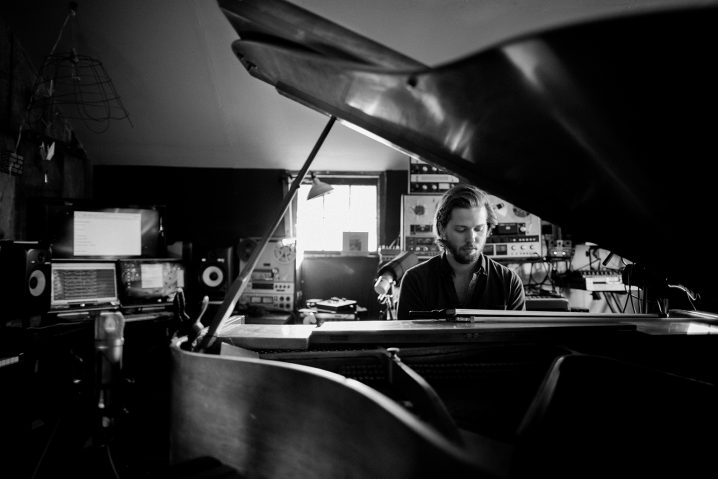
What does your live setup look like, and what do you bring with you when you travel for an extensive tour?
The last tour I did was a brief 2 1/2 week tour in EU last fall, but it was an incredibly clarifying and informative experience due to some some early technical problems that made me have to change my live setup on the fly. My step down 240/120V converter blew my portable mixer and multiple pedals/samplers I was relying on during sound check of the very first show. I had to very quickly rearrange my set and performance approach, since the setup I’d practiced with and performed with multiple times with was no longer possible. While it was definitely stressful in the moment! And it was pretty eye opening as to how I could pull off interpretations of my songs with a much more limited sound palette than I had previously thought possible.
My current setup revolves around guitar, voice, viola de gamba, an Akai MPX8 sampler to play percussion sounds and a few pedals. I play my 1959 Harmony Hollywood both as an acoustic and electric guitar (I put a LR Bagg lyric acoustic pickup inside) and run through two distinct signal paths so that with one guitar I can have pretty drastically different guitar sounds with their own unique effect chains running independently, simultaneously or intermittently overlapping. This was a big revelation for me since I was previous traveling with two guitars and was having to loop and switch instruments to create the same sort of complexity that I can get close to now in real time. My viola de gamba runs through the same effect chain as my acoustic and I use a Radial Tonebone PZ-Pre to toggle between the two and their distinct shelfing and EQ settings. For voice, I bring an Electro-Voice RE15 with me to run through a TC Helicon VoiceLive Touch for layering backing vocals and choir parts.
Right now the only change I would make between going on a tour that required flying and long travel would be to not travel with an amp, since it is a nightmare to tour with an amp that you really love and don’t want to see abused.

What is the most important environmental aspect of your current workspace and what would be a particular element that you would improve on?
This barn’s floor is made of thin redwood planks essentially act like a sound board. It is a very reverberant and live room. It is a joy to create and experiment here because sounds really move through this space and cause lots of instruments to resound. This quality is also its biggest downfall. I have had to live with the inevitable fact the floorboard creaks, outlier vibrations and other rickety artifacts will make their way into my recordings. Finding ways to temporarily tame the space for quieter recordings that don’t call for such rustic underpinnings is an ongoing project for me and one that I think could improve the quality of many of my recordings.
What can you tell us about your overall process of composition? How are the ideas born, where do they mature, and when do they finally see the light?
In order for me to keep up with my workload I have to be composing constantly. I probably have to make somewhere around 30-40 completed, mixed and mastered pieces of music each month just for my film work. This rapid rate of production definitely changes the way you have to workshop and create compositions. Over time I’ve gotten to the point that as soon as I am singing a motif or rhythmic figure in my head I already have an idea of how I want to record or capture it, and the process between writing and recording has moved so closely together that they’re virtually simultaneous.
For me capturing the spark and intensity of a new idea is vitally important, and I’d much rather throw out more ideas I took the time to record that were half-baked than have fewer ideas recorded that I’ve potentially over invested in. That can play mind games with you sometimes and make compositions feel too precious and potentially overwrought. This auditioning on the fly approach works well for me since I don’t have one instrument that is my primary tool and I can simply just compose on whatever instrument a piece is calling for; be it saxophone, cello, percussion, keys, voice, etc. This removes a step that many have to take and allows me to skip the mockup or sketch phase and head straight into mic’ing and recording each instrument like it’s the only chance I get to realize the piece. I am sure there is a lot of wasted energy and effort in this approach. Yet, it’s the only methodology I’ve found so far that can produce the amount of music demanded of me, at the quality I expect of myself without having to bring in a large number of collaborators.
Though my thought process on orchestration and production of my film compositions are pretty comparable to the songs I make for my records, the steps I have to go through to see them to completion is quite different. When working with a film there are so many embedded parameters to take into account before even playing your first note and this makes the writing process be far more reactive than free composition would be. I most often see films when they are in a rough edit form. From there, I will begin composing a number of pieces just trying to hone in on the gestalt of the film. I spend this time trying to explore what the feel, instrumentation, production aesthetic and general vibe of the music should be to really augment and enhance the story. At this point, it’s a fairly tedious dance of making scene specific cues that are coherent and stand well on their own but are also cogent and intrinsically linked somehow to the rest of score. All the while, accounting for the frustrating reality that there will be possibly dozens of edits and changes that will each inevitably alter the timing and effectiveness of the music’s fit with the scenes. So, even though the cues have a very organic birth and thoughtful maturation, they generally draw to completion with a mad dash to some deadline set by a major festival or other often arbitrary date that forces you to do damn near impossible changes and tweaks to the score in order to accommodate the bevy last-minute timing changes that most every film goes through. While this most often works out just fine, and you soon forget all the stress and compromises you had to make, it rarely gives you the same resounding buzz that you feel when you know that you’ve finished an album. It isn’t really until you get to see a screening of the film, often times 6-9 months later, that you can really feel that sense of satisfaction of knowing that it now has a life of its own.
For making records, I often just have an overarching concept or “problem” that I try to explore through making a collection of songs. I often times will have multiple projects going that I chip away at whenever I’m in that train of thought or ruminating on one of their respective pieces until I have a breakthrough with one of them. Once that happens, I become total obsessed and will fixate on realizing what I imagine to be an “album.” At that point, I normally wrangle in Ryan Keane, the head of my record label Lost Tribe Sound, to bounce ideas off of him and share what I think is a roadmap to a record. From there he offers his unique insight and critique as someone that has known me and my work for over a decade and a friend who knows how to push my buttons in a way that I don’t let my most glaring habits, tropes and oversights get in the way of the ultimate goal. Which is curating the best possible listening experience. This normally takes the form of him pleading me to go back to the vibe and imperfect alchemy of the earliest mixes.
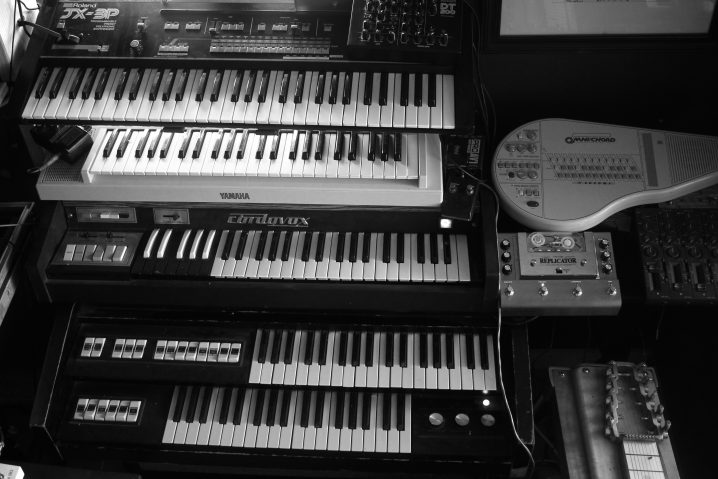
After the piece is complete, how do you audition the results? What are you reactions to hearing your music in a different context, setting, or a sound system?
I try to take my songs into as many listening environments I can before signing off on a mix. The car, my stereo setup, computer speakers, earbuds and the like are all tested for my records. However as much as you test in a variety of locations, I think it’s best to trust your most familiar and highest quality setup to determine how good a mix or master is, since the range of potential environments listeners digest your music can be maddeningly varied and compromised…. and I prefer not to think about optimizing my mix to sound good off an I-phone speaker in a public bus.
Do you ever procrastinate? If so, what do you usually find yourself doing during those times?
I am a dad now and I find that if I’m not in the throes of work (which is now often through the middle of the night) I am spending any and all free time playing with my daughter or cooking overly elaborate meals. These aren’t really diversions by any measure, but the last few months I’ve spent so much of my life existing in baby time that when my wife and my daughter are asleep I’m so hungry to make music that I have tunnel vision.
That being said, I certainly procrastinate on certain projects that just can’t seem to get their claws into me. If I’m working on a film or commercial piece that has stymied my creativity a bit I will often procrastinate by just getting lost in making a piece of music that is the total antithesis of whatever I’m having to make just to exorcise my compulsions to subvert an overly “safe” directive. I really love basketball and that used to be my #1 procrastination activity. When I was struggling to find a productive groove, and I’d be just empty minded shooting jump shots or looking up scores for NBA games and get lost in a brief trance until I’d catch myself like “shit I’ve only got 2 hours now to finish this stupid jingle!”

What gets you inspired?
Aside from the simple yet inexplicable vagrant moments of daily life which will forever be the biggest source of inspiration for me, the documentaries that I get to work on constantly turn me on to so many inspiring, depressing and beautiful stories. They often send me down rabbit holes of research to try and better understand a deeper context behind the film’s subject matter and that sense of curiosity these film’s stir up in me is invaluable for my creativity. I also try to stay pretty tapped into current global events and brilliant journalists like Amy Goodman/Democracy Now seem to always brings me to a place of deep concern or sickening disillusionment. It is easy to feel so overwhelmed by the mine field of complexity that most global sociopolitical issues are mired in, that all I can do is vent through music.
And finally, what are your thoughts on the state of “electronic music” today?
I think we are in the midst of a particularly fertile time for electronic music. The power and scope of digital music making tools is virtually limitless and it has both greatly democratized the process of creating recorded media and opened a pandora’s box of sonic possibilities for composers and sound artists to create some very radical and novel works that simply were not possible until very recently.
It is also highly exciting and encouraging the resurgence of new businesses creating beautiful hand-made analog hardware that gives artists amazingly musical, powerful and reliable tone creating and shaping tools that previously were only available in vintage pieces where the components and schematics were far more difficult to come by and expensive to maintain. With all of the increased accessibility of such instantly gratifying compositional and sound modeling tools comes the need to really sharpen skills self-editing and restraint, but from what I can hear there is no shortage of shockingly talented people who in the face of such bounteous possibilities still find ways to sound as singular and inventive as the most recognizable artists of any other era of modern music.
